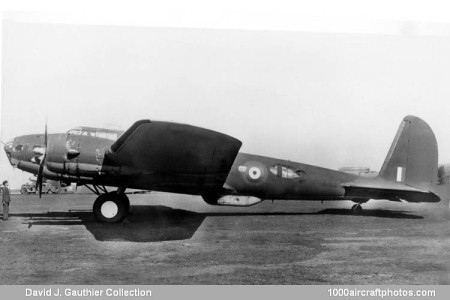Meanwhile, in the spring of 1941, 20 B-17C aircraft were flown to Britain for modification prior to delivery to the RAF as the Flying Fortress Mk.I under the serial AN518 to AN537. The Mk.I was a heavy bomber of all-metal stressed-skin construction, with a crew of ten. It was powered by four 1,200 hp Wright Cyclone R-1820G-205A radial engines. Armament consisted of a 0.303 in machine gun in the nose and two 0.50 machine guns in each of dorsal and ventral positions, plus two 0.50 machine guns through beams. It could carry a bomb-load of 2,500 lb (1,134 kg).
Entering service with No. 90 Squadron at West Raynham in May 1941, the Fortresses began operations from Polebrook with a raid by three aircraft on Wilhelmshaven on July 8, 1941. Flying by daylight at altitudes up to 30,000 ft (9,144 m), mostly on individual sorties (a technique much criticized by the Americans), No. 90's Fortresses had completed 26 raids by September 1941, including attacks on Emden, Kiel, Brest, Bremen, Rotterdam, Oslo, Borkum and Wilhelmshafen. They were far from successful.
In 51 sorties by individual aircraft, 26 were abortive and no bombs were dropped. There were difficulties with the Norden bomb-sight, numerous mechanical failures and a tendency for the guns to freeze up at altitude. Most serious defect of all was the inadequate defensive armament. All guns were manually operated and there was a blind spot at the tail. It was decided to abandon operations over Europe.
The Fortresses next operated with the RAF in the Middle East. Four were sent to Egypt, where they remained until May 1942, making night raids over Benghazi and attacking shipping in the Mediterranean. In October 1942 the surviving RAF Flying Fortress Mk.Is in Britain were transferred to No. 206 and No. 220 Squadron of Coastal Command for maritime reconnaissance. They were based at Benbecula in Scotland, where they remained until 1943, when they were superseded by the much-improved Mk.II.
The pictured aircraft was manufactured under the USAAC serial 40-2068, and was delivered to the RAF as AN531. Eventually it was struck off charge on January 17, 1945.
Span: 103 ft 9.5 in (31.64 m)
Length: 67 ft 10.5 in (20.69 m)
Height: 15 ft 4.5 in (4.69 m)
Wing area: 1,486 sq.ft (138 sq.m)
Weight empty: 31,150 lb (14,129 kg)
Loaded weight: 45,470 lb (20,625 kg)
Max speed: 320 mph (515 kmh) at 20,000 ft (6,096 m)
Cruise speed: 232 mph (323 kmh) at 14,000 ft (4,267 m)
Climb: 1,300 ft (396 m)/min
Range: 3,160 mls (5,058 km)
